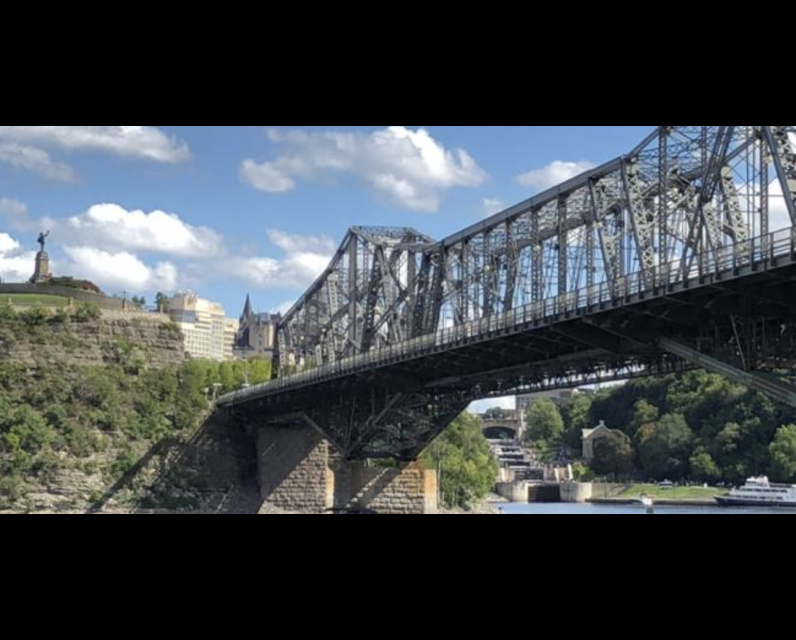Unpublished Opinions
Unpublished.ca is a web portal on politics and current affairs in Canada. It provides the opportunity for Canadians to dig deeper into the issues affecting them, and to weigh-in on these issues in a persuasive and respectful way. Join the movement and have your say today!
Historic Alexandra Bridge threatened by Federal Gov't

This press release was issued by Heritage Ottawa on behalf of the Alexandra Bridge Coalition
Ottawa, ON, April 30, 2021 -- The Alexandra Bridge Coalition proposes that the Alexandra Bridge be retained for its national heritage value and significance, and repurposed for green infrastructure transportation.
Keeping the Alexandra Bridge is the Sustainable Thing to do:
- Sustainability is a cornerstone of the Government of Canada’s policies on climate change. The greenest structure is the one that is already there. These principles should guide the debate on revitalizing the Alexandra Bridge.
- Even pre-pandemic, the Alexandra Bridge was supporting greener transportation. It carried 40 % of active pedestrian and cycling cross-river transportation, and only 9% of the vehicular traffic. This trend needs support not erasure.
- A repurposed Alexandra Bridge could accommodate a green-friendly Loop Tramway, better linking Ottawa and Gatineau along a significant, tourist-dominated route connecting the National Capital’s major destinations. The National Capital Commission has been charged with studying tramway options, and it just makes sense to consider the Alexandra Bridge in those studies.
- Conversion of the bridge to active transportation would alleviate much of the corrosion and load stresses brought on by vehicular traffic and would better ensure its maintainability and durability.
- Conversely, a new bridge designed to carry increased vehicular traffic would have a negative impact on the social sustainability of the residential neighbourhoods at both ends.
- Good sustainability practice calls for assessments of the amount of greenhouse gas emissions that would be produced by the demolition, materials removals, traffic detours, and construction of the new bridge, as opposed to retention of the existing bridge. But demolition is not necessary.
The Alexandra Bridge is significant because:
The Alexandra Bridge is of national historic importance for its historical, engineering, and environmental significance:
- The Alexandra Bridge was built by the Dominion Bridge Company in 1900, the first Canadian company to tackle an engineering feat of this scope.
- The Alexandra Bridge is an outstanding work of engineering as recognized by the Canadian Society of Civil Engineers. The engineering value of the Alexandra Bridge resides in its innovative design, featuring all steel construction and mid-truss deck. It is internationally recognized as an outstanding example of the cantilevered steel bridge type.
- The Alexandra Bridge is a key component of the nationally significant landscape of the Parliamentary precinct and its environs, encompassing monuments and landscape features on both sides of the Ottawa River.
The National Capital Commission’s own website refers to the Alexandra Bridge as: a major national landmark. It is recognized for its iconic beauty and world-class workmanship.
The Alexandra Bridge Coalition seeks:
- A reversal of the decision to demolish the bridge in favour of the revitalisation of the bridge for active transportation.
- In support of evidence-based decision-making, we request access to all studies: historical studies, engineering studies, options analyses, financial analyses, traffic studies, and environmental and cultural heritage impact studies.
- A peer-review of the decision to demolish the bridge.
- Full public consultation on the future of the bridge, not on how it should be commemorated after demolition. This includes consultations with the cities of Ottawa and Gatineau, and appropriate provincial partners.
- Referral to the Historic Sites and Monuments Board of Canada for consideration as a national historic site.
- Stabilization and maintenance of the structure according to the Standards and Guidelines for the Conservation of Historic Places in Canada.
- A management plan posited upon a future as an active-transportation bridge. This plan should be created through public consultation and signed by the minister responsible.
For more information, please contact:
Claude Royer claude.royer@gmail.com 613-295-4115 cellulaire (porte-parole, en français)
Jordan Ferraro jordanrobertferraro@gmail.com 613-862-5004 cell/text (spokesperson, English)
Co-signatories:
The National Trust for Canada
Heritage Ottawa
La Fédération Histoire Québec (FHQ)
Architectural Conservancy of Ontario (ACO)
Architects DCA
La Société d’histoire de l’Outaouais (SHO)
Transport Action Canada
Greenspace Alliance for Canada’s Capital
Action Vélo Outaouais (AVO)
L’Association des résidents de l’Île de Hull (ARIH)
L’Association du patrimoine du ruisseau de la Brasserie (APRB)
Lowertown Community Association
Manor Park Community Association
Action Sandy Hill
LA COALITION POUR LE PONT ALEXANDRA
veut un avenir vert pour le pont Alexandra!
Le gouvernement fédéral propose la démolition du pont Alexandra
Conserver le pont Alexandra est la solution durable :
- Le développement durable est une pierre angulaire de la politique du gouvernement du Canada sur les changements climatiques. Les structures les plus écologiques sont celles qui existent déjà. Ces principes devraient orienter toute modernisation du pont Alexandra.
- Même avant la pandémie, le pont Alexandra encourageait le transport actif. Il était utilisé par 40 % des piétons et des cyclistes qui traversaient la rivière, et par seulement par 9 % des véhicules automobiles. Cette tendance doit être encouragée, et non condamnée.
- Le pont Alexandra reconverti pourrait accueillir une boucle de tramway écologique qui permettrait de mieux relier Ottawa et Gatineau le long d’une route importante empruntée par les touristes qui relie toutes les destinations principales de la capitale nationale.
- La transformation du pont en infrastructure de transport écologique réduirait grandement les effets de la corrosion et des charges associés à la circulation automobile; cela en faciliterait la maintenance et en assurerait la viabilité.
- Au contraire, un nouveau pont conçu pour une circulation automobile accrue aurait des répercussions négatives sur la durabilité des quartiers résidentiels situés à chacune de ses extrémités.
- Les pratiques exemplaires en matière de durabilité exigent l’évaluation de la quantité d’émissions de gaz à effet de serre qui serait produite par la démolition, le retrait des matériaux, les détournements de circulation ainsi que la construction du nouveau pont par rapport à la conservation du pont existant. Tout cela alors que sa démolition n’est pas nécessaire.
Pourquoi le pont Alexandra est-il important?
Le pont Alexandra a une importance historique nationale en raison de sa portée historique, environnementale et d’ingénierie :
- Le pont Alexandra a été construit en 1900 par la Dominion Bridge Company, la toute première entreprise canadienne à relever un défi d’ingénierie de cette importance.
- Le pont Alexandra est une œuvre d’ingénierie remarquable reconnue par la Société canadienne de génie civil. La valeur d’ingénierie du pont Alexandra se retrouve dans sa conception novatrice présentant une fabrication entièrement en acier et un tablier central en treillis. Le pont est un exemple remarquable de pont cantilever en acier, reconnu internationalement.
- Le pont Alexandra fait part intégrante du paysage de la Cité parlementaire, un paysage qui englobe des éléments architecturaux et des monuments d’importance nationale des deux côtés de la rivière des Outaouais.
Le site Web de la Commission de la capitale nationale décrit le pont Alexandra comme un lieu d’intérêt national important. Il est reconnu pour sa beauté emblématique et sa construction remarquable.
Quel est l’objectif de la coalition pour le pont Alexandra?
- Un renversement de la décision de démolir le pont en faveur de sa transformation en infrastructure de transport écologique (transport actif et transport en commun).
- Afin d’appuyer la prise de décisions fondée sur des données probantes, nous demandons un accès à toutes les études : études historiques, études techniques, analyses des options, analyses financières, études de circulation et études d’impact environnemental et sur le patrimoine culturel.
- Une revue indépendante des critères de la décision de démolir le pont.
- Une consultation publique complète sur l’avenir du pont, et non sur la façon de le commémorer après sa démolition. Cela comprend des consultations avec les villes d’Ottawa et de Gatineau ainsi qu’avec les partenaires provinciaux appropriés.
- Une recommandation auprès de la Commission des lieux et monuments historiques du Canada pour considérer le pont comme un lieu historique national.
- La stabilisation et la conservation de la structure conformément aux Normes et lignes directrices pour la conservation des lieux patrimoniaux au Canada.
- Un plan de gestion axé sur l’avenir du pont en tant que pont de transport écologique. Ce plan doit être établi à la suite de consultations publiques et signé par le ministre responsable.
Pour obtenir de plus amples renseignements, veuillez communiquer avec :
Claude Royer, claude.royer@gmail.com 613-295-4115 cellulaire (Porte-parole Français)
Jordan Ferraro, jordanrobertferraro@gmail.com 613-862-5044 (Spokesperson English)
Co-signataires :La Fiducie nationale du Canada
Patrimoine Ottawa
La Fédération Histoire Québec (FHQ)
La Société d’histoire de l’Outaouais (SHO)
Architectural Conservancy of Ontario
Architects DCA
Transport Action Canada
Action Vélo Outaouais (AVO)
Alliance pour les espaces verts de la capitale du Canada
L’Association des résidents de l’Île de Hull (ARIH)
L’Association du patrimoine du ruisseau de la Brasserie (APRB)
L’Association communautaire de la Basse-Ville
Manor Park Community Association
Action Côte-du-Sable



Comments
Be the first to comment